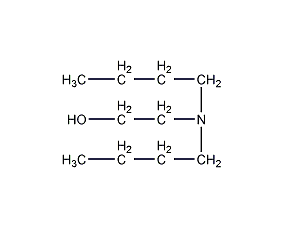
Structural formula
| Business number | 02MH |
|---|---|
| Molecular formula | C10H23NO |
| Molecular weight | 173.30 |
| label |
N,N-Dibutylaminoethanol, N,N-Dibutylethanolamine, Di-n-butylethanolamine, Polyurethane catalyst, fiber additives, emulsifier |
Numbering system
CAS number:102-81-8
MDL number:MFCD00014033
EINECS number:203-057-1
RTECS number:KK3850000
BRN number:1738441
PubChem ID:None
Physical property data
1. Properties: colorless liquid with slight ammonia odor.
2. Density (g/mL, 20/20℃): 0.8615
3. Relative vapor density (g/mL, air=1): 6.0
4. Melting point (ºC): -75
5. Boiling point (ºC, normal pressure): 228.7
6. Refractive index (20ºC): 1.444
7. Flash point (ºC, open): 93.3
8. Viscosity (mPa·s, 20ºC): 7.7
9. Viscosity (mPa·s, 25ºC): 6.50
10. Viscosity (mPa·s, 60ºC): 1.94
11. Volume expansion coefficient (K-1): 0.00114
12. Solubility: slightly soluble in water, soluble in methanol, ethanol, ether, aromatic hydrocarbons, ethyl acetate, slightly soluble in hydrocarbons.
Toxicological data
1. Skin/eye irritation: Start irritation test: rabbit skin contact, 100mgREACTION SEVERITY, strong reaction; Standard Dresser test: rabbit skin contact, 5mg/24HREACTION SEVERITY, strong reaction; 2. Acute toxicity: Rat oral LD50 : 1070mg/kg; Rat peritoneal cavity LD50: 144mg/kg; Mouse peritoneal cavity LD50: 52mg/kg; Rabbit skin contact LD50: 1680μL/kg; Mammalian peritoneal cavity LD50: 120mg/kg; 3. Other multiple dose toxicities : Rat oral TDLo: 7mg/kg/5W-C; rat inhalation TCLo: 70ppm/6H/5D-I;
Ecological data
This substance is slightly hazardous to water.
Molecular structure data
1. Molar refractive index: 53.63
2. Molar volume (cm3/mol): 198.3
3. Isotonic specific volume (90.2K ): 472.4
4. Surface tension (dyne/cm): 32.1
5. Dielectric constant:
6. Dipole moment (10– 24cm3):
7. Polarizability: 21.26
Compute chemical data
1. Reference value for hydrophobic parameter calculation (XlogP): 2.1
2. Number of hydrogen bond donors: 1
3. Number of hydrogen bond acceptors: 2
4. Number of rotatable chemical bonds: 8
5. Number of tautomers: none
6. Topological molecule polar surface area 23.5
7. Number of heavy atoms: 12
8. Surface charge: 0
9. Complexity: 77.9
10. Number of isotope atoms: 0
11. Determine the number of atomic stereocenters: 0
12. Uncertain number of atomic stereocenters: 0
13. Determine the number of chemical bond stereocenters: 0
14. Number of uncertain chemical bond stereocenters: 0
15. Number of covalent bond units: 1
Properties and stability
Avoid contact with strong oxidants, strong acids, and strong alkalis.
Storage method
Store in a cool, ventilated warehouse. Keep away from fire and heat sources. They should be stored separately from oxidants, acids, alkalis, and food chemicals, and avoid mixed storage. Equipped with the appropriate variety and quantity of fire equipment. The storage area should be equipped with emergency release equipment and suitable containment materials.
Synthesis method
Originated from the reaction of dibutylamine and ethylene oxide.
Purpose
Used as solvent, extractant and in organic synthesis. Used as polyurethane catalyst, fiber additive and emulsifier.

 微信扫一扫打赏
微信扫一扫打赏

